
Algae are any of a large and diverse group of photosynthetic, eukaryotic organisms. The name is an informal term for a polyphyletic grouping that includes species from multiple distinct clades. Included organisms range from unicellular microalgae, such as Chlorella, Prototheca and the diatoms, to multicellular forms, such as the giant kelp, a large brown alga which may grow up to 50 metres (160 ft) in length. Most are aquatic and lack many of the distinct cell and tissue types, such as stomata, xylem and phloem that are found in land plants. The largest and most complex marine algae are called seaweeds, while the most complex freshwater forms are the Charophyta, a division of green algae which includes, for example, Spirogyra and stoneworts. Algae that are carried by water are plankton, specifically phytoplankton.

Fucus is a genus of brown algae found in the intertidal zones of rocky seashores almost throughout the world.

Alaria esculenta is an edible seaweed, also known as dabberlocks or badderlocks, or winged kelp, and occasionally as Atlantic Wakame. It is a traditional food along the coasts of the far north Atlantic Ocean. It may be eaten fresh or cooked in Greenland, Iceland, Scotland and Ireland. It is the only one of twelve species of Alaria to occur in both Ireland and in Great Britain.

Ulva lactuca, also known by the common name sea lettuce, is an edible green alga in the family Ulvaceae. It is the type species of the genus Ulva. A synonym is U. fenestrata, referring to its "windowed" or "holed" appearance, Despite the name, it is not a lettuce

Ceramium is a genus of Ceramium algae. It is a large genus with at least 15 species in the British Isles.
Elsie May Burrows was an English botanist who made significant contributions to British postwar phycology. Her primary area of research was macroalgal ecology, focusing particularly on Fucus, a genus of brown algae, and Chlorophyta, a division of the green algae.
The history of phycology is the history of the scientific study of algae. Human interest in plants as food goes back into the origins of the species, and knowledge of algae can be traced back more than two thousand years. However, only in the last three hundred years has that knowledge evolved into a rapidly developing science.

Colpomenia peregrina, sometimes referred to by its vernacular names oyster thief and bladder weed, is a species of brown seaweed.
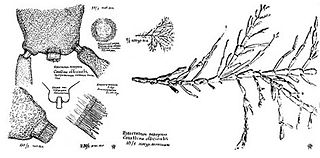
Corallina officinalis is a calcareous red seaweed which grows in the lower and mid-littoral zones on rocky shores.
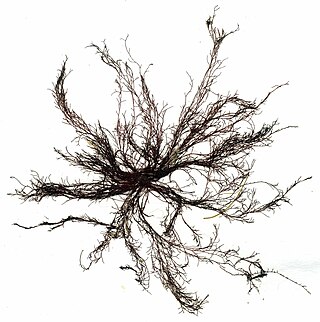
Polysiphonia is a genus of filamentous red algae with about 19 species on the coasts of the British Isles and about 200 species worldwide, including Crete in Greece, Antarctica and Greenland. Its members are known by a number of common names. It is in the order Ceramiales and family Rhodomelaceae.

Codium fragile, known commonly as green sea fingers, dead man's fingers, felty fingers, forked felt-alga, stag seaweed, sponge seaweed, green sponge, green fleece, sea staghorn, and oyster thief, is a species of seaweed in the family Codiaceae. It originates in the Pacific Ocean near Japan and has become an invasive species on the coasts of the Northern Atlantic Ocean.
Characium marinum is a species of green algae (Chlorophyta).
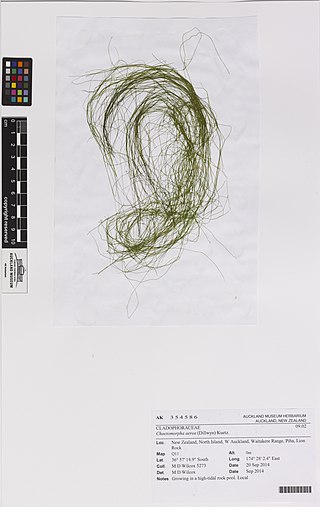
Chaetomorpha aerea is a species of green algae of the family Cladophoraceae.

Chaetomorpha linum is a species of green algae in the family Cladophoraceae.

Polysiphonia lanosa is a common species of the red algae (Rhodophyta) often to be found growing on Ascophyllum nodosum.
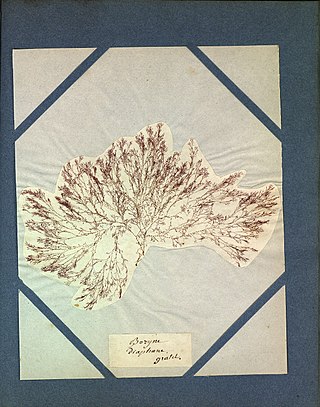
Ceramium diaphanum is a species of marine red algae.
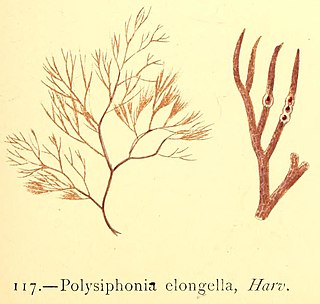
Polysiphonia elongella Harvey in W.J. Hooker is a branched species of marine red algae in the genus in the Polysiphonia in the Rhodophyta.
Prasiola furfuracea is a small green alga that grows terrestrially.

Codium bursa is a green marine algae of medium size.
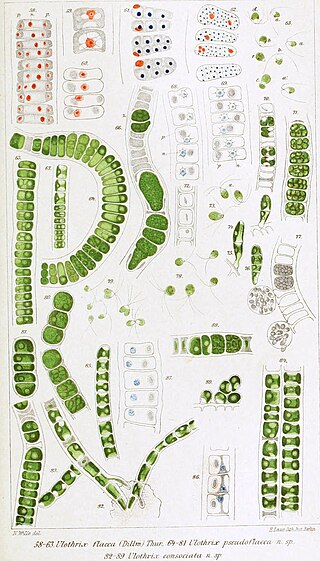
Ulothrix flacca is a small filamentous marine algae.
















